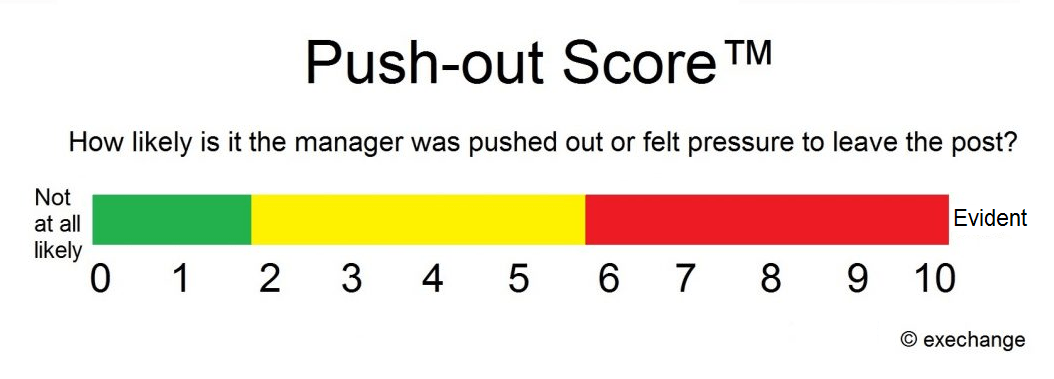
Frequently Asked Questions
Does a relatively high Push-out Score™ mean that the manager was pushed out?
The Push-out Score gauges the likelihood that a manager was pushed out or felt pressure to leave the position. When a manager is not openly pushed out, there is no totally reliable way of classifying the management change as forced or voluntary.
Is a relatively high Push-out Score bad?
The Push-out Score is neither good nor bad. Interpretation is always a matter of perspective. A relatively high Push-out Score indicates a high likelihood that the manager was pushed out or may have felt relatively high pressure to leave the position — nothing more and nothing less. At the same time, a relatively high Push-out Score may indicate that the manager has navigated the toughest waters and was able to withstand enormous pressure. Even the most experienced captain in the world is powerless against the fury of the sea.
Is the Push-out Score a measure of strength or weakness of the manager?
We score events. We don’t score people. The Push-out Score is not intended to be seen as a measure of strength or weakness of the manager. The Push-out Score must always be seen in the context of the whole situation.
The Push-out Score is high and the management change is an honorable departure. Isn’t that an apparent contradiction?
There is not always a correlation between Push-out Score and type of departure. A high Push-out Score and an honorable departure are not mutually exclusive, perfectly possible and not all that uncommon.
The Push-out Score is relatively high, and the manager was definitely not pushed out. The board even tried to persuade the manager to stay. How does that fit together?
A relatively high Push-out Score indicates a high likelihood that the manager was pushed out or may have felt relatively high pressure to leave the position. It does not indicate that a manager was actually pushed out. A manager may decide to quit on their own volition in times of high pressure and stress, depending on opportunities elsewhere. A decision to leave the post may also be completely independent of push-out forces. Correlation does not imply causation.
The Push-out Score indicates a high likelihood for a forced turnover, but the manager takes a superior position elsewhere. How does that fit together?
A management change may be triggered by push-out forces (e.g., board, activist shareholders), pull-out forces (e.g., new career opportunities, “an offer that can’t be refused”) or a combination of push-out forces and pull-out forces. For a meaningful result, signs of push-out forces and signs of pull-out forces should be considered together.
The Push-out Score is 1. What does that mean?
In our opinion, one sign alone is not significant.
Why is the Push-out Scoring System™ based on the nine parameters Form, Language, Age, Notice period, Tenure, Share price, Official reason, Circumstances and Succession?
Form, Language, Age, Notice period, Tenure, Share price, Official reason, Circumstances and Succession are proxy variables. A proxy variable is an easily measurable variable that is used in place of a variable that cannot be measured or is difficult to measure. Push-out forces are unobservable and immeasurable. The Push-out Scoring System was developed in close interaction with our highly professional readers. It is a proven method designed to provide the foundation for pragmatic and unbiased information and to enhance transparency. If you prefer, you can also work with different parameters.
The Push-out Scoring System is based on nine parameters, each with the same weight. Shouldn’t the scores be weighted differently for the individual criteria?
Keep it simple. As far as our experience goes, it is expedient to give equal importance to the nine parameters Form, Language, Age, Notice period, Tenure, Share price, Official reason, Circumstances and Succession. However, if you prefer to weight the nine parameters individually, you can do it.
Why is the Push-out Scoring System an open-source method?
We decided to make the Push-out Scoring System an open system because our readers prefer glass boxes over black boxes, and open-source methods benefit from outside perspective and creativity.
What happens if someone does not agree with the Push-out Score and other assessments from exechange?
Our principle is the following: Facts are holy, rumors are deadly, opinions are ours. We correct misspelled names or incorrect data immediately. Opinions are a matter of perspective. Freedom of opinion is important, and opinion is not negotiable. Our highly professional readers and clients appreciate well-founded opinions. We always back up assessments and sentiments with facts. Even then, our opinion remains subjective and sometimes a matter of taste. We are aware that not everyone values our opinion. Considered from different perspectives, assessments vary. Our proven method and rigorous research provide the foundation for unbiased information. Our code of conduct commits us to maintain high ethical standards in our research and in all business practices. exechange is an independent, closely held business information specialist. We are committed to helping our customers make prudent decisions, reduce risk and benefit from enhanced transparency.
What can a manager do in the case of disagreement with the assessments from exechange?
We are bold enough to make assessments, and we stand by our rigorous and meticulous research. We are humble enough to know we will never know the whole story, let alone the whole truth. In our view, there is no such thing as the whole truth. There are many truths we can tell. In the case of disagreement, we offer the manager an opportunity to give us an interview. An interview gives the manager a chance to comment and gives our readers and clients a broader perspective. We strive for accuracy in our reporting. Suggestions and comments from our readers are always welcome.
I am interested in an assessment of a special case. Can you help?
Yes, we can. Please contact us at editors@exechange.com and we will submit an individual offer based on your specific requirements.
If you have any other questions, please contact us at editors@exechange.com.
